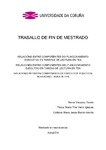| dc.contributor.advisor | Vieiro Iglesias, Pilar | |
| dc.contributor.advisor | Manso Revilla, María Jesús | |
| dc.contributor.author | Vázquez Varela, Nerea | |
| dc.contributor.other | Universidade da Coruña. Facultade de Ciencias | es_ES |
| dc.date.accessioned | 2019-12-13T12:12:33Z | |
| dc.date.available | 2019-12-13T12:12:33Z | |
| dc.date.issued | 2019 | |
| dc.identifier.uri | http://hdl.handle.net/2183/24490 | |
| dc.description.abstract | [Resumo]: A lectura é un proceso mediante o cal os seres humanos poden interpretar uns caracteres para
a posterior comprensión dun texto. Para que esta comprensión poida ter lugar son necesarios
uns procesos cognitivos que permitan unha boa análise e integración da información.
Estes procesos cognitivos teñen lugar grazas ás funcións executivas, como son a memoria de
traballo, que é un sistema que permite almacenar información ao mesmo tempo que estes
datos son utilizados para a execución de tarefas cognitivas complexas e o control atencional,
que supón manter unha atención selectiva durante períodos prolongados de tempo, inhibindo
así comportamentos automáticos e irrelevantes, permitindo centrar o uso dos recursos a nivel
cognitivo na realización dunha tarefa concreta.
O obxectivo principal do presente estudo é realizar unha análise descritiva do nivel de eficacia en tarefas de control executivo nun suxeito con trastorno do espectro autista (TEA) en medidas de memoria de traballo, control inhibitorio e procesos atencionais. Para isto
empréganse diversas probas como son o ReadingSpan Test, o Test Stroop de Cores e
Palabras, o DysexecutiveQuestionnaire e a subproba de Span de Debuxos do WISC-V. | es_ES |
| dc.description.abstract | [Abstract]: Reading is a process by which humans can interpret some characters for the further
understanding of a text. So that this understanding can take place are necessary cognitive
processes that allow a good analysis and integration of the information.
These cognitive processes take place through executive functions, such as working memory,
which is a system that allows you to store information while these data are used for the
execution of complex cognitive tasks and the attention control, which involves maintaining
selective attention for prolonged periods of time, thereby inhibiting automatic and irrelevant
behavior, allowing focus on the use of resources at the cognitive level in carrying out a
specific task.
The main objective of the present study is to perform a descriptive analysis of the level of
effectiveness in tasks of executive control in a subject with autism spectrum disorder (ASD)
in working memory measures, inhibitory control and attention processes. For this, several
tests are used, such as the Reading Span Test, the Test Stroop of Colors and Words, the
Dysexecutive Questionnaire and the WISC-V Drawing Sub-Test. | es_ES |
| dc.language.iso | glg | es_ES |
| dc.subject | TEA | es_ES |
| dc.subject | Funcións executivas | es_ES |
| dc.subject | Atención | es_ES |
| dc.subject | Memoria | es_ES |
| dc.subject | Inhibición | es_ES |
| dc.subject | ASD | es_ES |
| dc.subject | Executive functions | es_ES |
| dc.subject | Memory | es_ES |
| dc.subject | Attention | es_ES |
| dc.subject | Inhibition | es_ES |
| dc.title | Relacións entre compoñentes do funcionamento executivo en tarefas de lectura en TEA | es_ES |
| dc.title.alternative | Relaciones entre componentes del funcionamiento ejecutivo en tareas de lectura en TEA | es_ES |
| dc.title.alternative | Relations between components of executive function in reading tasks in TEA | es_ES |
| dc.type | info:eu-repo/semantics/masterThesis | es_ES |
| dc.rights.access | info:eu-repo/semantics/openAccess | es_ES |
| dc.description.traballos | Traballo fin de mestrado (UDC.CIE). Neurociencia. Curso 2018/2019 | es_ES |






